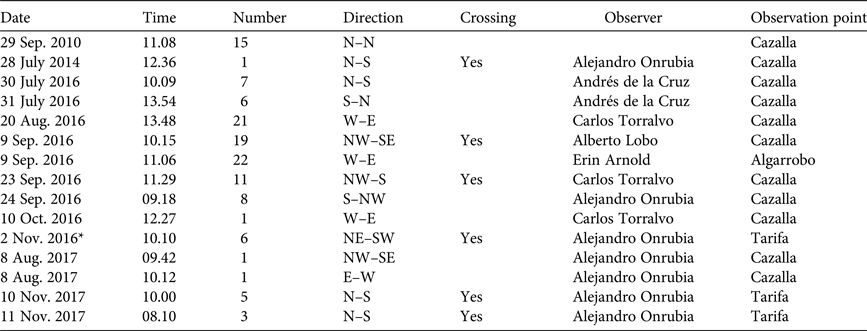The report of six northern bald ibis Geronticus eremita arriving in Morocco from Spain in November 2016 (Muñoz & Ramirez, Oryx, 51, 204–205) was claimed to be the first confirmed sighting of the reintroduced Spanish population crossing from Europe to Africa. Significantly, there have been several additional sightings of birds leaving from Spain and crossing to Africa before and since this date (Migres Foundation, 2016 & 2017, Unpublished Reports). We present these data and cross-reference them to timings and information from the reintroduction project Proyecto Eremita (López & Quevedo, 2016, pp. 54–57, in Boehm & Bowden, eds, Northern Bald Ibis Conservation & Reintroduction Workshop) in Andalusia, Spain.
Post-breeding observations of soaring birds since 1999, by the Migres Foundation observation teams at Tarifa, Cazalla and Algarrobo in southern Spain during July–December, have recorded northern bald ibises on at least 15 occasions (Table 1). These have mainly been birds leaving Spain towards Morocco. The highest numbers were observed in 2016, and these include the six birds confirmed to arrive in Tangiers by Muñoz & Ramirez. Table 1 shows crossings both before and after, as well as a group in July 2016 that appears to have made the crossing and then returned, minus one individual, to Spain the following day.
Table 1 Summary of all sightings of northern bald ibis Geronticus eremita by the Migres Foundation.

*The same birds were seen arriving in Tangiers by Muñoz & Ramirez (2017).
The observation of 11 birds that crossed on 23 September 2016 is of interest because 11 hand-reared juveniles, released as part of a larger group of 25 in July, disappeared from Proyecto Eremita on that day. None of these subsequently returned to the project. All Proyecto Eremita birds are fitted with unique coded darvic rings. Only the observation in 2014 was confirmed to be an adult. Most birds making the crossing seem likely to be hand-reared juveniles. The birds that crossed towards Morocco in early November 2017 did not, however, coincide with a disappearance from Proyecto Eremita.
In 2016 a total of 101 northern bald ibises were observed crossing or part-crossing the Gibraltar Straits in nine separate observations. Many of these sightings undoubtedly involved the same birds passing, but 36 birds (observations on three separate dates) were observed crossing to the south. It is possible that at least some of the birds returned to Spain undetected during this period. A minimum of 19 birds were seen crossing to Morocco on 9 September 2016, and it is possible that the six observed on 2 November were surviving birds from that larger group, attempting the crossing back to Spain (having already set off north from Morocco).
The Proyecto Eremita reintroduced population has now successfully bred 90 free-flying ibises, and 25 pairs bred in the wild in 2017 with no significant intervention. These birds remain largely sedentary (regularly moving up to 45 km but rarely more than this). Austrian work to establish free-flying ibises reported multiple long-distance movements (several hundred km) of mainly juveniles, and only by enclosing the birds each autumn did they remain in the area (Fritz et al., 2017, International Book Yearbook, 51, 107–123), and enclosure in autumn is also used at Proyecto Eremita. Whether this population will develop a regular dispersion or migration pattern to the south remains unclear, and the continued monitoring and marking of the free-flying Proyecto Eremita juveniles is important, to differentiate between these and the possibility of sightings involving the slowly increasing, fully wild Moroccan birds dispersing to the north.
We thanks the full Migres Foundation team, and specifically Andrés de la Cruz, Carlos Torralvo, Erin Arnold and Alberto Lobo for their observations.



